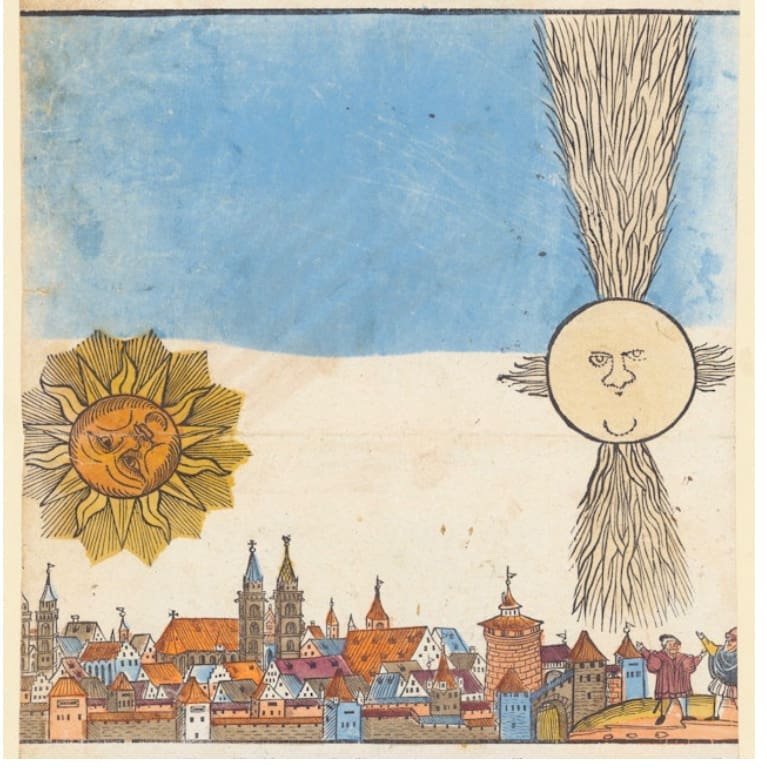
The Nuremberg Celestial Phenomenon
February 21, 2025
The Nuremberg Celestial Phenomenon, which transpired on April 14, 1561, represents one of the earliest recorded incidents regarded by many as an encounter with unidentified flying objects (UFOs). This event occupies a unique position in historical documentation and the ongoing discourse regarding the possibility of extraterrestrial life. The Nuremberg occurrence reflects the beliefs and interpretations of people in the 16th century and provides a foundation for modern interpretations and investigations by ufologists.
To fully appreciate the significance of the Nuremberg Celestial Phenomenon, it is essential to consider the historical context in which it occurred. The mid-16th century was a time of considerable upheaval in Europe, with the Protestant Reformation challenging established religious norms and beliefs. The heavens were seen as an extension of the divine, with celestial events often interpreted as omens or messages from God. Such a worldview would have profoundly influenced the inhabitants of Nuremberg, a city that served as a center for commerce and culture in the Holy Roman Empire.
The primary source of information about the Nuremberg Celestial Phenomenon comes from a broadsheet—a printed pamphlet standard in the 16th century used to deliver news and sensational events to the public. The broadsheet, attributed to a local artist named Hans Glaser, depicted the extraordinary events that transpired in the early morning sky. The vivid illustrations and accompanying text describe a chaotic spectacle involving numerous objects of various shapes and sizes that appear locked in a struggle.
Witnesses described seeing orbs—some shaped like spheres, others resembling elongated cylinders—flying in formation across the dawn sky. The broadsheet articulated that these objects emitted vibrant colors and intense light. Accounts indicated that the objects switched positions rapidly, darting back and forth as if engaging in aerial combat. The cacophony of sound described by observers resembled cannon fire or the clanging of bells, leading many to believe that a war was taking place among celestial beings.
The document became an essential piece of early print media, shaping public perception and fostering both awe and fear among the citizens of Nuremberg. People interpreted the event along religious lines, believing that the display was either a divine omen or a sign of impending conflict, particularly when political and religious tensions were escalating throughout Europe.
In the contemporary era, the Nuremberg Celestial Phenomenon has sparked the interest of historians, researchers, and ufologists, who employ various lenses to analyze this extraordinary event. A key aspect of modern studies involves examining the possibility of natural explanations for the incident. Some researchers posit that atmospheric phenomena could have triggered the sightings. The 16th century lacked advanced scientific understanding, leading individuals to attribute extraordinary celestial phenomena to supernatural causes. Potential explanations include sightings of meteorological phenomena, such as falcon-tailed comets, rare atmospheric conditions like parhelia (sun dogs), or other optical illusions.
Ufologists have also noted the parallels between the Nuremberg event and modern-day UFO sightings. Some argue that the accounts reflect a broader human experience with the unknown. The phenomenon in Nuremberg has inspired debates about whether we are alone in the universe and encourages speculation about long-term interactions between humankind and extraterrestrial life.
The Nuremberg Celestial Phenomenon remains a significant landmark in the history of unidentified aerial phenomena. The intricate interplay between eyewitness accounts and the era’s socio-religious context generated a narrative that resonates through the centuries. While the broadsheet from 1561 serves as the primary historical document recording this event, its implications have extended far beyond the initial spectacle.
Modern society continues to grapple with questions about extraterrestrial life and our place in the universe. Whether viewed through history, culture, or ufology, the Nuremberg incident is a compelling reminder of our fundamental impulses to explore and understand what lies beyond the known and the familiar.
The Nuremberg Celestial Phenomenon broadsheet translated by Ilse Von Jacobi:
In the morning of April 14, 1561, at daybreak, between 4 and 5 a.m., a dreadful apparition occurred on the sun, and then this was seen in Nuremberg in the city, before the gates, and in the country – by many men and women. At first, two blood-red semi-circular arcs appeared in the middle of the sun, just like the moon in its last quarter. And in the sun, above and below and on both sides, the color was blood; a round ball of partly dull, partly black ferrous color stood. Likewise, there stood on both sides and as a torus about the sun, such blood-red ones and other balls in large numbers, about three in a line and four in a square, and some alone. In between these globes, there were visible a few blood-red crosses, between which there were blood-red strips, becoming thicker to the rear and in the front malleable like the rods of reed grass, which were intermingled, among them two big rods, one on the right, the other to the left, and within the small and big rods there were three, also four and more globes. These all started to fight among themselves so that the globes, first in the sun, flew out to the ones standing on both sides; thereafter, the globes standing outside the sun, in the small and large rods, flew into the sun. Besides, the globes flew back and forth among themselves and fought vehemently with each other for over an hour. And when the conflict in and again out of the sun was most intense, they became fatigued to such an extent that they all, as said above, fell from the sun down upon the earth ‘as if they all burned,’ and they then wasted away on the earth with immense smoke. After all this, there was something like a black spear, very long and thick, sighted; the shaft pointed to the east, and the point pointed west. Whatever such signs mean, God alone knows. Although we have seen, shortly after another, many signs in heaven, which are sent to us by the almighty God to bring us to repentance, we still are, unfortunately, so ungrateful that we despise such high signs and miracles of God. Or we speak of them with ridicule and discard them to the wind so that God may send us a frightening punishment for our ungratefulness. After all, the God-fearing will by no means discard these signs but will take it to heart as a warning of their merciful Father in heaven, will mend their lives, and faithfully beg God that He may avert His wrath, including the well-deserved punishment, on us, so that we may temporarily here and perpetually there, live as his children. For it, may God grant us his help, Amen











